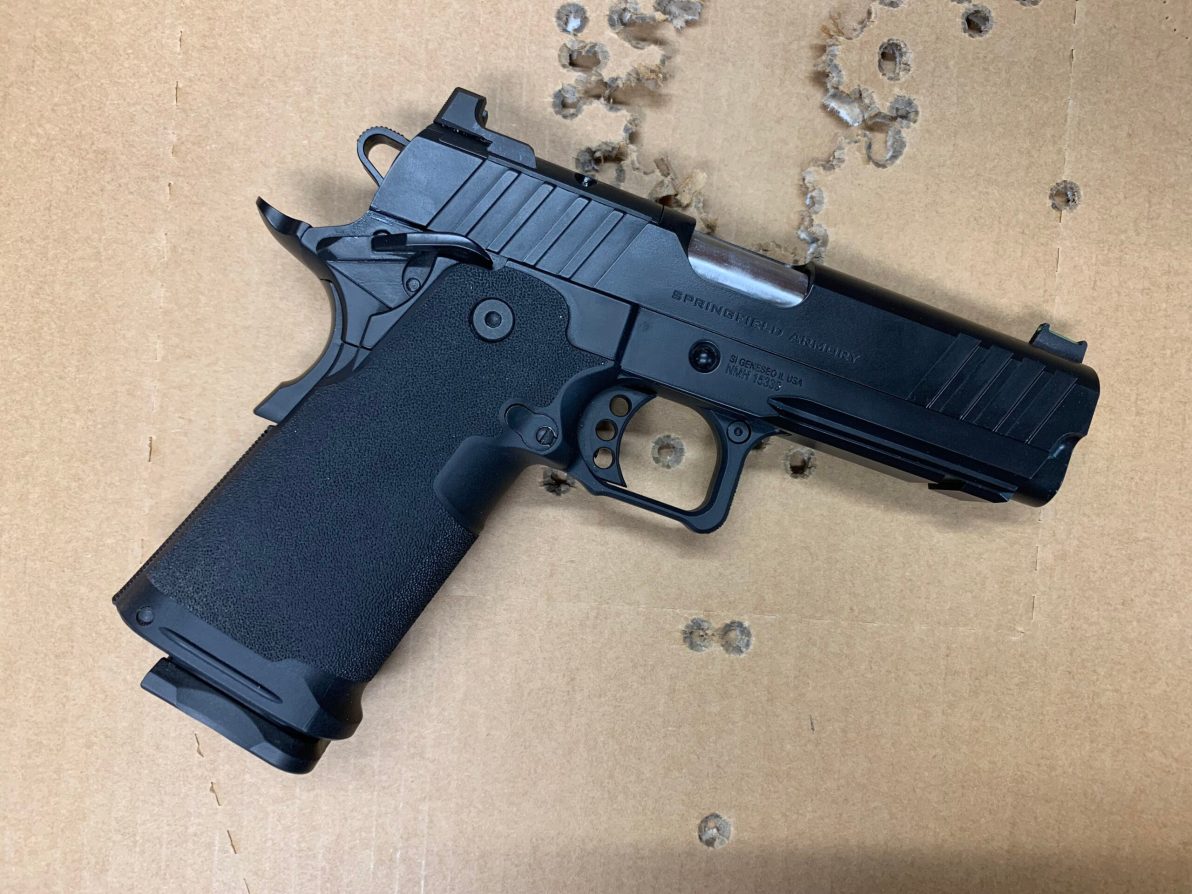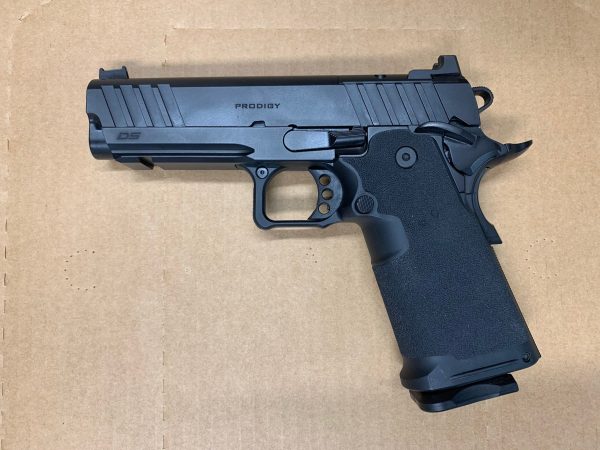We may earn revenue from the products available on this page and participate in affiliate programs. Learn More ›
In September of last year, Springfield Armory made waves when they announced their new pistol: the 1911 DS Prodigy. The Springfield Prodigy is offered in 4.25- and 5-inch models and was immediately seen as heaven-sent by some; a general-production, more-affordable 2011-style 9mm pistol for the masses. Others viewed the new pistol with incredulity, not believing it to be worth the vaunted “2011” designation. My only certainty was that I wanted to test it for myself.
1911 Vs. 2011
The 1911 needs no introduction, and 1911 pistols have been around for more than a century at this point. The 2011 is a more recent phenomenon. Chances are that even if you don’t know what a 2011 is, you’ve heard that they’re special; something to be spoken about in hushed tones and not directly gazed upon.
In reality, it’s pretty simple, the 2011 is a Staccato. The company formerly known as STI was reborn as Staccato and trademarked the nomenclature “2011.” You’ll still hear and see folks referring to similarly styled pistols as “2011’s,” but many of them technically aren’t.
When you hear or see someone refer to a pistol as a 2011, and it’s not a Staccato, they’re referring to some of the basic design features that the pistols share. In rudimentary terms, a 2011 or 2011-style pistol is just a double-stack 1911 that’s chambered in 9mm. Unlike a traditional 1911, which has a frame that makes that up the handle and has grip scales on both sides, a 2011-style pistol’s frame terminates at the top of the grip. It uses a grip module, usually polymer, that attaches to the frame.
The Springfield 1911 DS Prodigy is similar in many ways to the Staccato P model pistol, and much of the initial buzz around the Springfield Prodigy is about whether it’s a more affordable competitor to the premium-priced 2011’s and other 2011-style pistols.
Springfield 1911 DS Prodigy 4.25-Inch Specs and Features
- Caliber: 9mm
- Capacity: 17+1 or 20+1
- Action: Single-action, hammer-fired
- Barrel: 4.25-inch, bull profile, stainless steel, 1:16-inch twist
- Dimensions: 7.8 inches (L) x 5.5 inches (H) x 1.28 inches (W)
- Weight: 37 ounces (w/empty 17-round magazine) (weighed)
- Frame: Carbon steel, forged
- Slide: Carbon steel, forged
- Optics: Cut for optic, uses Agency Arms adapter plates
- Controls: Right-handed slide stop, mag catch, ambidextrous safety levers
- Finish: Black Cerakote
- Grip: Polymer grip module, fine stipple texture
- Sights: Fiber-optic front, serrated black “U-notch” rear (drift adjustable
- Trigger: Aluminum, single-action, curved shoe, 4 pounds, 0 ounces (measured)
- MSRP: $1499
Frame and Slide
The slide and frame of the Springfield Prodigy are both forged carbon steel and fit precisely together. The slide has a normal 1911-style profile and simple diagonal cocking serrations on both front and back. The steel/fiber-optic front sight is fitted into the slide via a dovetail. The Firing pin, firing pin spring, and extractor look and function as they would on any 1911.
The rear/top of the slide is cut for mounting a red dot optic but includes a rounded cover plate with a tall black serrated rear sight installed. A version of the Prodigy is available with Springfield’s Hex Dragonfly optic installed from the factory. Agency Arms makes the optic adapter plates that are available through Springfield for a variety of other optic footprints. A unique and nice feature is that the plates drop into a half-dovetail at the rear of the optic cut. This should help support the plate and prevent all the shear force from going into the screws when the gun is fired.
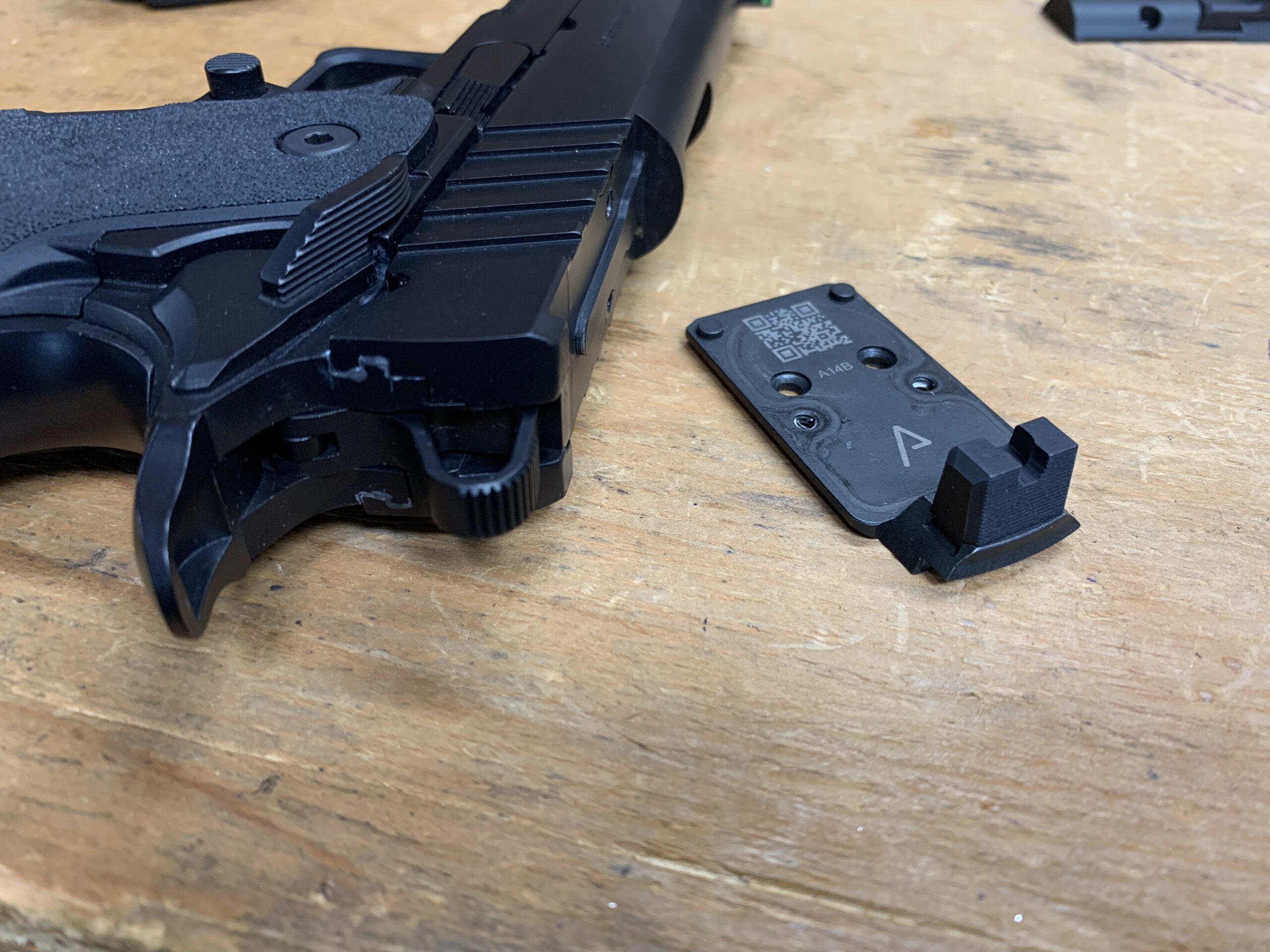
The frame has a single-slot accessory rail for attaching a light and the slide and frame are both finished with black Cerakote. Cerakote is an interesting choice, perhaps more affordable, for coating the slide and frame. It looks ok, but does feel more like a painted coating, which it is, than a blued or DLC finish.
Many pistols feature DLC-type finishes that are durable and not paint-like. Cerakote finishes are common on contemporary hunting rifles, but they do show wear rather quickly on bearing surfaces between moving parts. Carbon steel rusts very quickly if not coated or kept oiled, so it’s something a user should monitor.
Grip Module
The Springfield Prodigy has a thick-but-comfortable grip. The polymer grip module is noticeably beefier than a single-stack 1911 grip or even that of many double-stack striker-fired pistols. Still, it’s easy to find a secure and repeatable grip. The grip has a fine stipple texture on the sides and front, and a checkered texture on the backstrap below the grip safety.
A small area below the trigger guard is slightly recessed and smooth, allowing the shooter to choke up against the trigger guard. The front of the trigger guard has a small bit of the fine stipple texturing, but the trigger guard itself has beveled edges that mesh nicely with the fingers on the strong and support hands as they press against it.
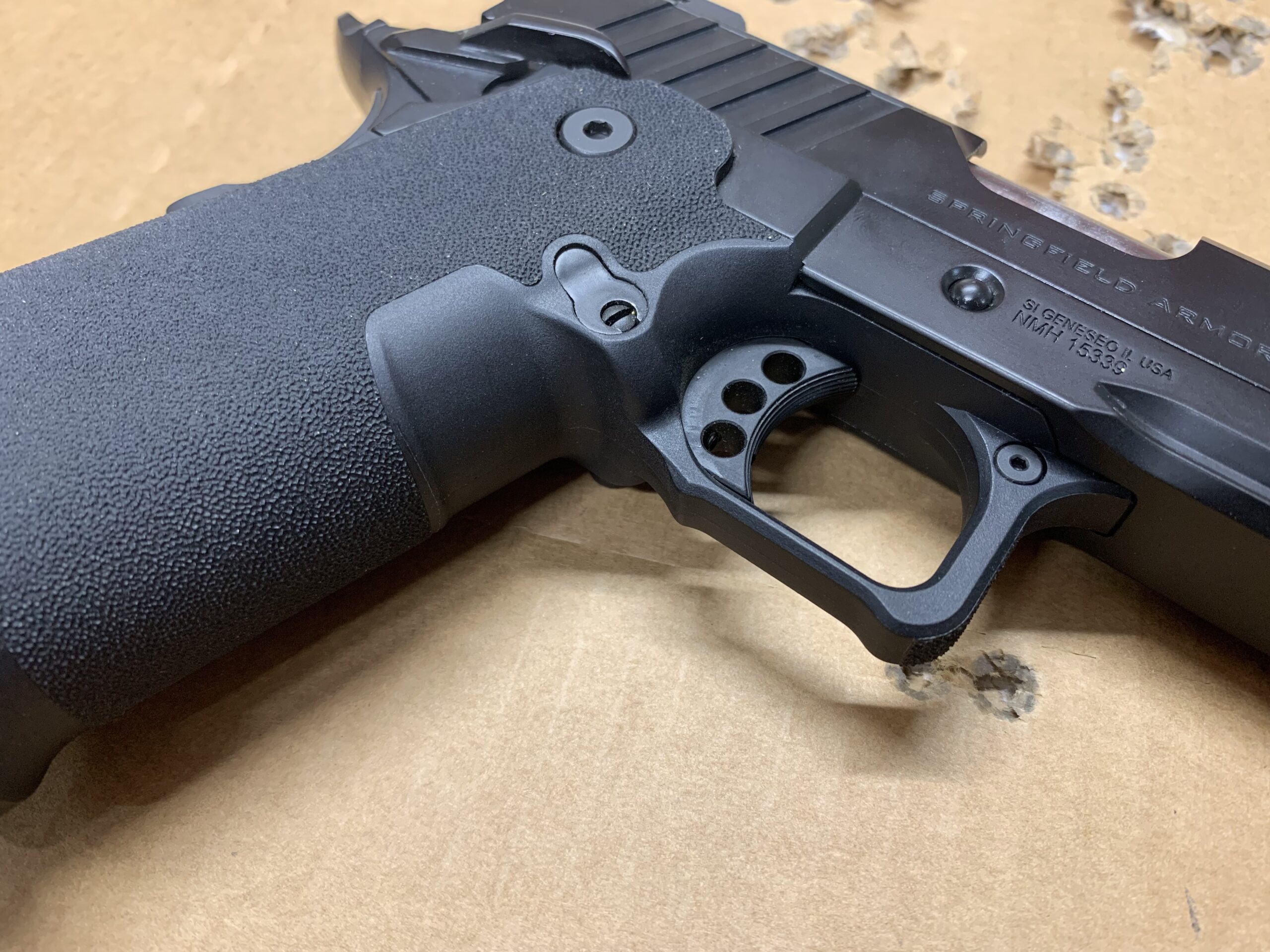
Trigger and Controls
The trigger on the Springfield Prodigy has a curved shoe that’s made of aluminum. It has a small set screw to control overtravel that’s set from the factory. The magazine catch button is slightly extended and has a serrated/ribbed texture. The thumb safety has a medium-long sweeping beavertail.
Controls are predominately righthanded on this pistol, but it features dual safety levers that give it some ambidextrous function. The magazine catch is not reversible.
The safety lever is easy to reach and offers lots of real estate to rest my thumb on. It disengages with an audible and tactile “click.” However, when the safety is disengaged, there is a bit of cushion at the bottom—something you won’t see on high-end 1911’s and 2011-style pistols. After clicking the safety off, you can press the lever down another .063 inches. Let go and spring tension will bring it back. This might not be a big deal to you, but some shooters get persnickety about things like that.
Barrel and Internals
The barrel on the Prodigy is forged from stainless-steel. It’s a bushing-free bull-profile barrel that’s 4.25 inches long and .695 inches in diameter at the muzzle. It tapers down slightly, back towards the two locking lugs, and features the classic 1911 rotating barrel link.
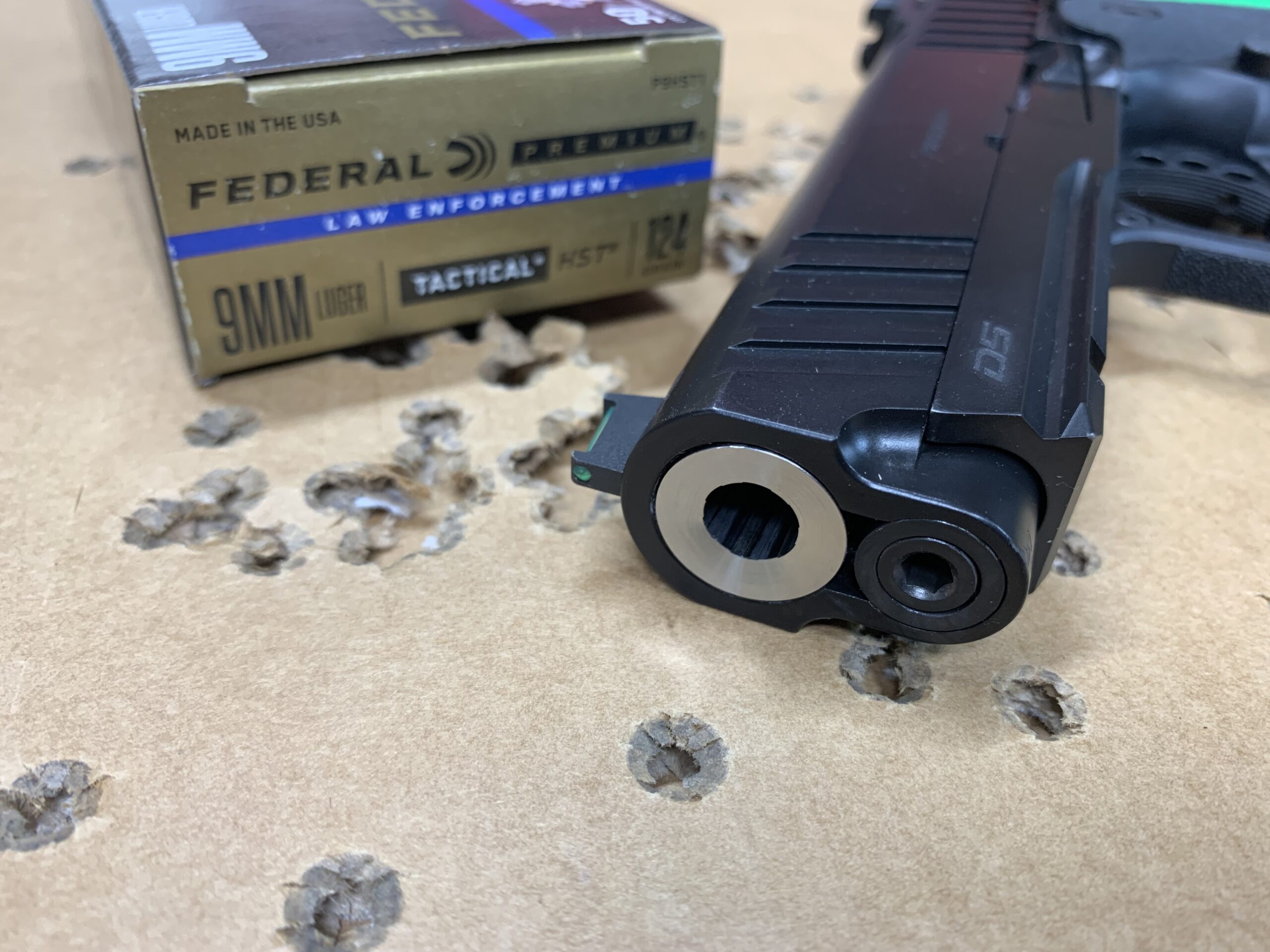
The Springfield Prodigy comes with a two-piece guide rod that acts as a full-length rod when assembled. The back half is like a GI-length guide rod but threaded on the end. The recoil spring is placed over the rear portion of the guide rod, then when installed under the barrel, the spring is slid into an open-ended spring plug. The front half of the guide rod is then pushed from the front, through the spring, and threaded onto the rear portion of the guide rod. It’s tightened with an Allen key.
Many of the internal parts, a point of ire with some reviewers, are injection-molded and not forged. Forged and hand-fit parts are nicer, but plug-and-play parts aren’t necessarily a bad thing. Many guns use injection-molded metal parts to cut costs and speed up production. Even the hottest-shit Sig P365s, Glocks, or M&Ps are full of stamped and molded parts.
Magazines
The Springfield Prodigy comes with a 17- and a 20-round magazine. The magazines are made by Duramag and appear to be well built. They have a black-finished steel body, steel spring, polymer followers, and polymer baseplates. They look similar to Staccato 2011 magazines and will function in a Staccato P.
Staccato magazines will also function in the Prodigy, and some early run users reported feeding issues with the factory magazines that were remedied by switching to Staccato brand mags. The Staccato magazines only cost about $10 more than the Springfield mags so, if feeding is an issue, it could be worth trying one. I did notice that the factory magazines were a little finicky to load and when fully loaded, there was usually a round or two rattling in the magazine; that didn’t seem to affect feeding or reliability with my sample.
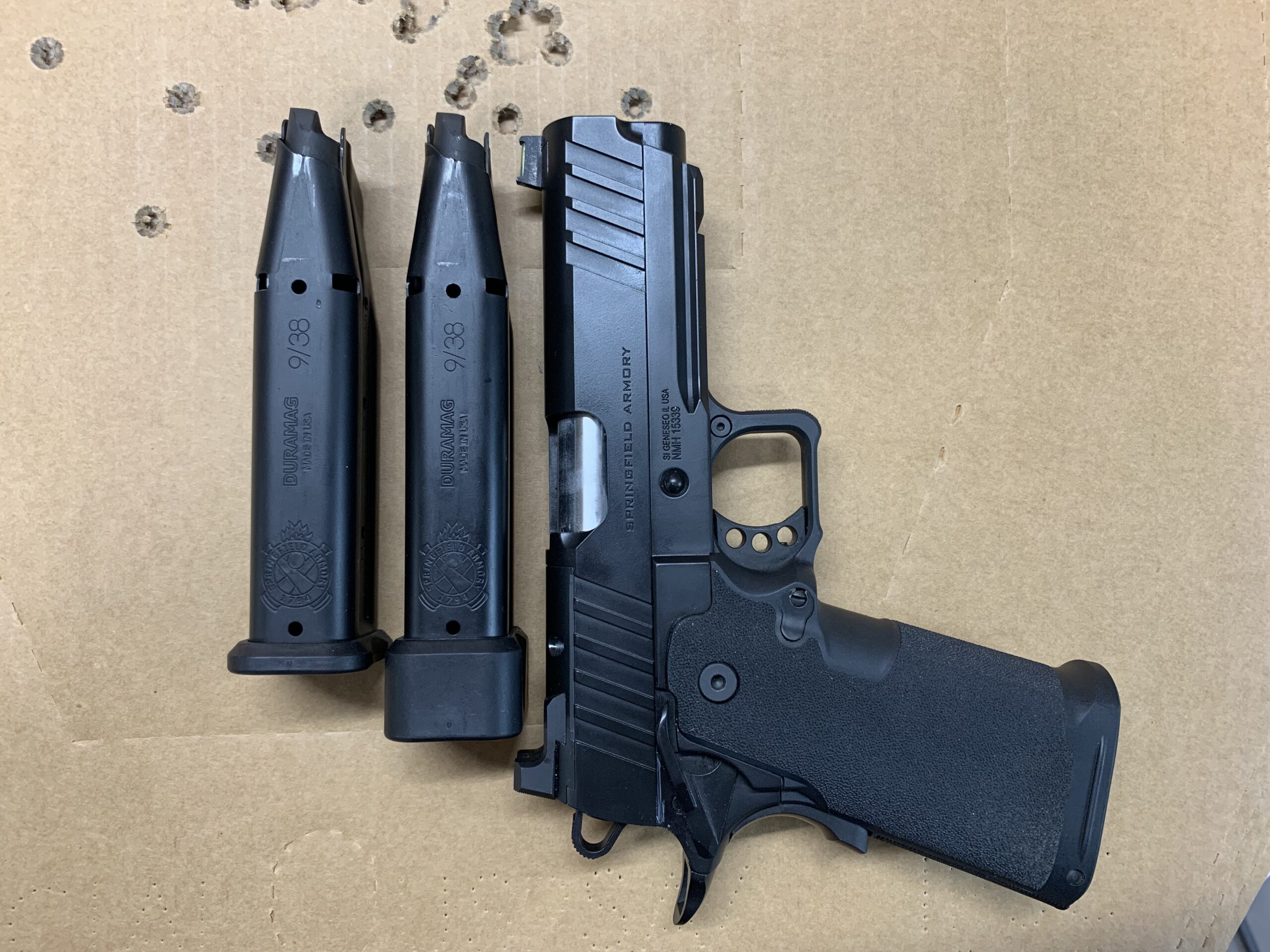
The Springfield 1911 DS Prodigy 4.25-Inch on the Range
I was eager to see how smoothly the Springfield Prodigy would run, how easy it would be to maintain a good grip and run fast repeatable shots, and ultimately, how reliable it would be. I received my sample in December, which gave me the benefit of snooping around to see what early reviewers and folks that know 1911’s and 2011’s better than I do had to say. Early results and opinions were certainly mixed. It’s common for new releases to have some bugs that need working out; now I’d know what issues to look for.
It often takes 100 to 200 rounds to break in a handgun and I’ll usually feel comfortable reviewing one after firing 300 rounds or so. With some early published reviews knocking the gun for reliability issues, I decided to put at least a thousand rounds through the gun before passing judgement.
On the range, I evaluate handguns in three different areas: handling, practical accuracy, and reliability.
How the Springfield Prodigy Handles
I like the grip on the Prodigy. The stippling texture gives me good traction and there is plenty of real estate for my support-hand to gain some purchase on the grip too. It feels and points like a thick-waisted 1911. The cocking serrations bite hard and provide plenty of purchase. I like to rack pistols from the front of the slide with my thumb and the web of my hand; it’s effortless with this pistol. Slide manipulation is butter-smooth, and I can detect only a tiny amount of slop or movement in the slide/frame interface—even after 1,000 rounds.
The trigger is very good on my Prodigy, and it breaks cleanly at four pounds even (as measured on my Lyman trigger pull scale). I’ve felt better triggers on race guns like the CZ TS 2 Racing Green, but this one had a short take-up, broke clean, and was a couple ounces lighter than the trigger on the Staccato P that I have.
Loaded magazines snap into the grip module easily and racking the first round is smooth. With the beavertail on the grip safety, it’s easy to index a rock-solid grip to drive this gun. The magazine catch requires a slight repositioning of the hand for me to reach, but it’s still easy and intuitive. The Prodigy doesn’t include a magwell, but the inside edges of the grip are beveled and receive the bottlenecked magazines easily. Empty mags all fall free from the grip for me when working on rapid reloads from a gunbelt.
My only complaint about the controls of the Springfield Prodigy is that the slide stop is difficult to engage manually. The slide stop lever is sunk into the frame to make it flush with the frame and the end is tricky to manipulate; it’s very difficult to do one-handed. It’s also difficult to drop the slide with the shooting hand thumb. With the thumb safety depressed, the Springfield Prodigy’s grip is approximately 0.063 inches longer, front-to-back, than the Staccato P’s grip. That difference isn’t big, but it makes it generally necessary to operate the Prodigy’s slide stop with my support-hand thumb. I can’t reach it with my right thumb without breaking grip.
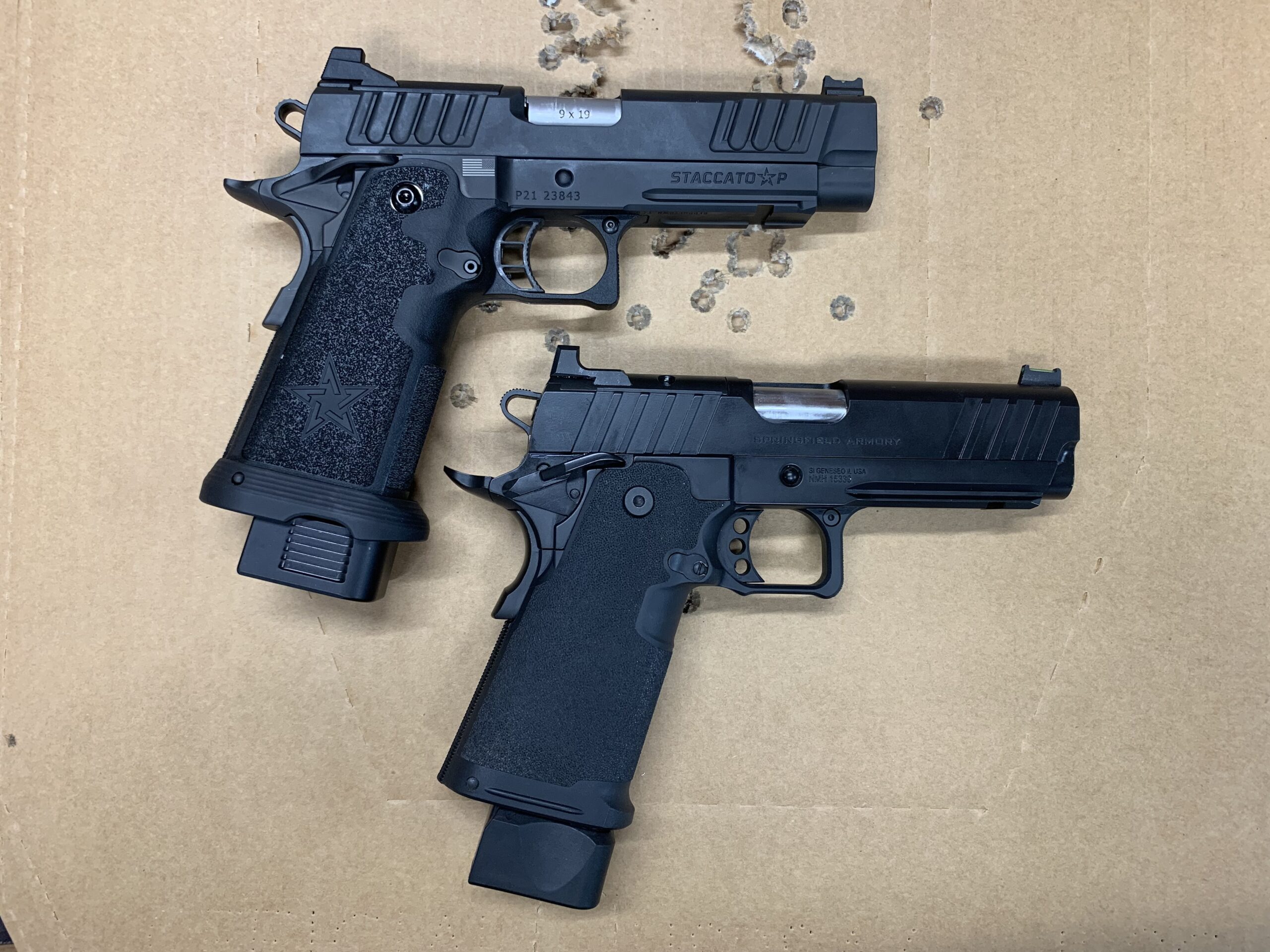
I have the good fortune of getting to shoot quite a few pistols, and I believe I’ve fired close to 10,000 rounds of 9mm in the last twelve months. I can say with confidence that the Springfield Prodigy is one of the fastest and smoothest-shooting pistols I’ve fired in a long time. The CZ TS 2, Nighthawk Custom President, and Staccato P, are the only pistols I’ve fired in the last year that edge it out in smoothness, controllability, and pure pleasure.
The clean break of the Prodigy’s trigger is followed by a soft and quick recoil and return to battery. When gripping the pistol properly, the front sight snaps right back to where it was when the trigger broke. I’ll not laud it to the point of nausea, but shooting it made me want to throw my G19 in the garbage can after leaving the range.
How Accurate is the Springfield Prodigy?
I shot the Springfield Prodigy with both iron sights and a Trijicon RMR. It’s easy to shoot accurately with both, and I noted that the iron sights are tall enough to co-witness through the optic. That’s a nice feature in case your battery fails at a bad time. Like many 1911-style pistols, the Prodigy points naturally, and the clean-breaking trigger makes it easy to place rounds where they need to go.
I didn’t spend a lot of time shooting measured groups, but with a red-dot, I could easily keep two-handed un-supported shots inside a three-inch target sticker at 50 feet. Maintaining a tight cluster in the A-zone on a USPSA/IPSC target while shooting only slow enough to catch the reset was a breeze. It’s a pistol that lends itself to forgiving, accurate shooting; certainly, accurate enough for an entry-level competitive 2011-style pistol.
Another way I like to gauge how easily a pistol is to shoot accurately, and improve my skills, is to fire counted strings as fast as possible at a USPSA/IPSC target at 21 feet. I’ll fire strings of one, two, three, four, and five rounds as fast as I can, working on maintaining my grip and sight picture. After most sessions of 150 to 200 rounds, only four or five shots had found their way outside the “A-zone” and the center was a ragged hole. It’s an easy gun to shoot well.
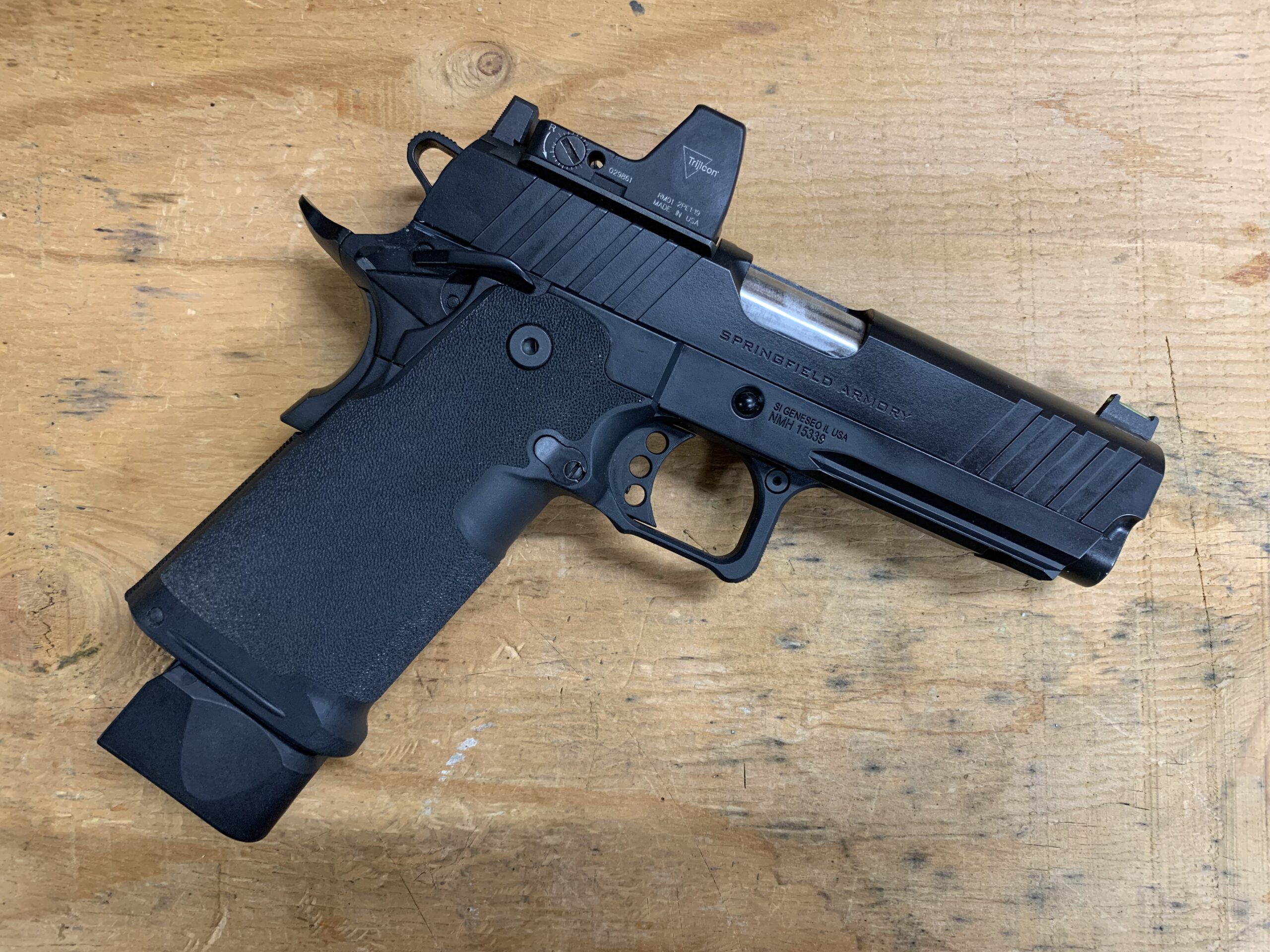
Is the Springfield Prodigy Reliable?
I couldn’t ignore some of the reviews and videos discussing the issues that some early 1911 DS Prodigy buyers and reviewers encountered. I’d seen reports of feeding issues caused by both magazines and the slide being slowed down by a stiff disconnector on some pistols. I’d heard of some trigger issues too. Most of the reliability issues were being blamed on the injection-molded internal parts.
I hoped that my sample, which was several months after the first run, would have those issues ironed out. Running over 1,000 rounds through the gun would surely reveal any hidden reliability issues, and I’m pleased to report that my sample ran like a scalded dog.
Read Next: Favorite Guns of 2022
I encountered five total malfunctions, in the approximately 1,100 rounds fired. All five were with 115-grain Federal Syntech flat-nose factory loads. I had three rounds stick on the feed ramp in the first magazine I fired through the gun when new. After that, the only hiccups I had were two feed ramp sticks in one magazine with the same ammo while shooting weak-hand-only. That was after not cleaning the gun for 300 rounds or so. I concluded that the problem was a matter of my limp left wrist rather than the gun. I can’t speak for all the Springfield Prodigy pistols out there, but I would certainly vouch for this one’s reliability. I fired a wide variety of ammunition with the Prodigy: 115-, 124-, and 147-grain Federal flat-nose Syntech ammunition, 115- and 124-grain Remington UMC, 124-grain Federal HST hollowpoints, 90-grain +P Black Hills Honey Badger, 135-grain Federal Hydra Shok, 147-grain Federal HST hollowpoints, 147-grain Hornady XTP hollowpoints, Winchester 147-grain FMJ, Nosler 147-grain ASP hollowpoints, and Federal Premium 147-grain +P Solid Core ammunition.
The one reliability-related component I’d critique is the two-piece guide rod. I didn’t have any functionality issues with it, but at the end of each shooting session, it was no longer tight. Since it’s necessary to disassemble the rod to clean the pistol, it’s not a part you want to put thread-locker on. Just keep an eye on it.
What the Springfield Prodigy Does Well
I think the Springfield Prodigy brings a lot of performance for its price point. It has an ultra-smooth slide-to-frame fit and a nice barrel. The grip module is nicely profiled and textured, the trigger is good, and it’s a fun and fast gun to shoot.
Where the Springfield Prodigy Could Be Better
The biggest ways that the Prodigy could be better are a slightly shorter (front-to-back) grip that allows one-handed operation of the controls. A slide stop that’s easier to operate would be a plus too. I’d also prefer a guide rod design that doesn’t loosen as easily.
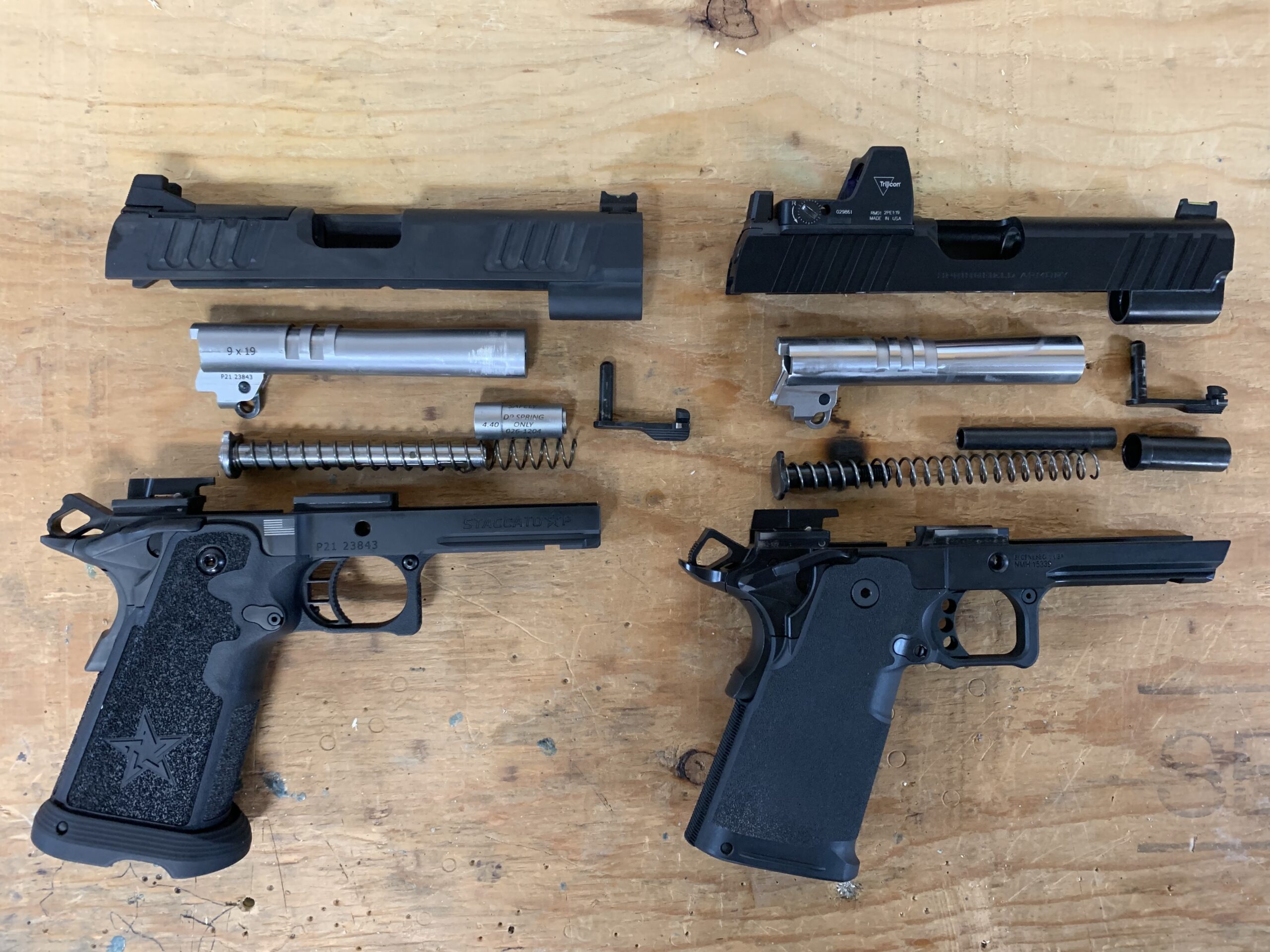
Final Thoughts
For many shooters, the 2011-style pistol has been nothing more than aspirational; a genuine STI or Staccato on the local range is something special that people still walk over to look at. With a big-name company like Springfield Armory bringing a 2011-style pistol to market, the burning question around the Springfield Prodigy is: how does it compare?
The question is perfectly understandable, but I think it’s the wrong one to ask. They’re two different guns that are about a thousand bucks apart in price. They’re really targeting different market segments altogether. The most comparable 2011, the Staccato P, looks a lot like the 1911 DS Prodigy, but its materials, parts, finishes, and attention to detail put it in a different category than any mass-produced pistol. The Prodigy is an excellent-shooting pistol that feels a lot like the Staccato P, but if the genuine article is what you want, just shell out and buy it. The Staccatos have plenty of appreciable qualities that justify the higher price tag.
To be truly fair to the Springfield Prodigy, it should only be compared to the Staccato in style only. It’s an accurate, fast, smooth-shooting pistol that’s a solid performer for its price. The Prodigy is an excellent option for someone who’s wanting to get a good-quality entry-level double-stack 1911 for fun or to compete with. A $1,500 pistol isn’t exactly cheap but, like the appreciable gap between the Springfield Prodigy and premium 2011-style pistols, the Prodigy I tested was in a different league than just about any $600 to $1,300 striker-fired pistol I’ve shot.
